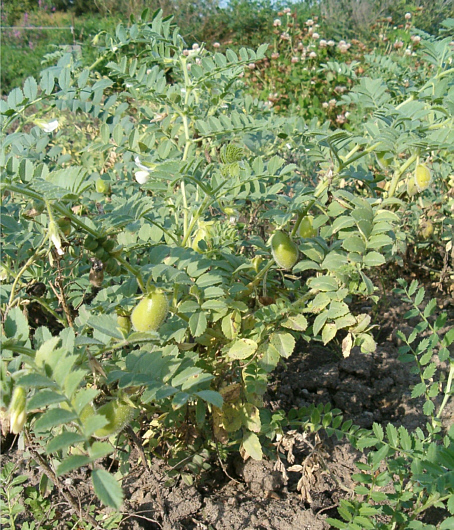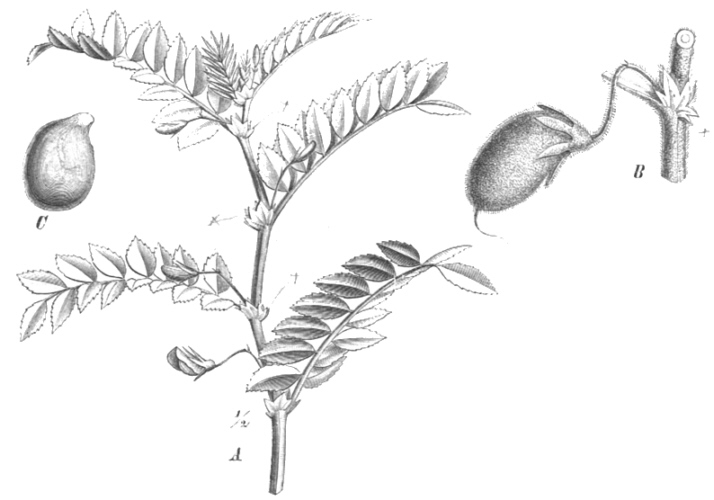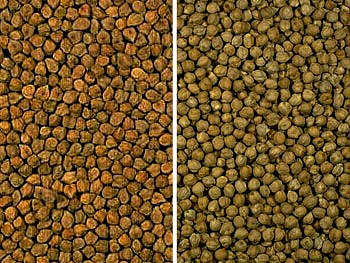

Zitierweise / cite as:
Carakasaṃhitā: Ausgewählte Texte aus der Carakasaṃhitā / übersetzt und erläutert von Alois Payer <1944 - >. -- Anhang A: Pflanzenbeschreibungen. -- Cicer arietinum L. -- Fassung vom 2007-07-12. -- URL: http://www.payer.de/ayurveda/pflanzen/cicer_arietinum.htm
Erstmals publiziert: 2006-07-12
Überarbeitungen:
Anlass: Lehrveranstaltung SS 2007
Dieser Text ist Teil der Abteilung Sanskrit von Tüpfli's Global Village Library
WARNUNG: dies ist der Versuch einer
Übersetzung und Interpretation eines altindischen Textes. Es ist keine
medizinische Anleitung. Vor dem Gebrauch aller hier genannten Heilmittel wird
darum ausdrücklich gewarnt. Nur ein erfahrener, gut ausgebildeter ayurvedischer
Arzt kann Verschreibungen und Behandlungen machen!
Falls Sie die diakritischen Zeichen nicht dargestellt bekommen, installieren Sie eine Schrift mit Diakritika wie z.B. Tahoma.
Verwendete und zitierte Werke siehe: http://www.payer.de/ayurveda/caraka0001.htm

Abb.: Kichererbse - Cicer arietinum L.
[Bildquelle. Wikipedia]

Abb.: Kichererbse - Cicer arietinum L.
[Bildquelle. Wikipedia]

Abb.: Kichererbsen - Cicer arietinum L.
[Bildquelle. Wikipedia]
Drury:
"Cicer arietinum (Linn.) N. O. Leguminosae. Common Chick-pea, Bengal gram, Eng. Kadala, Mal. Kadalay, Tam. Sanegaloo, Tel. Chenna, Hind. Boot-kaley, Chuna, Beng.
Description.—Herbaceous, annual plant; calyx 5-lobed, scarcely gibbous, segment as long as the alae of the corolla; leaves unequally pinnated; leaflets ovate, serrated, equal; stipules lanceolate, somewhat toothed; corolla papilionaceous; flowers axillary, bluish purple; legumes hairy. Fl. Sept.—Oct.—W. & A . Prod. i. 235.—Roxb. Fl. Ind. iii. 324— Wight Icon. t. 20.-------Cultivated.
Medical Uses.—This plant is employed by the natives as a refrigerant in fevers. In the Deccan it is used by the Portuguese in the treatment of dysmenorrhoea ; the fresh plant is put into hot water, and the patient sits over the steam.—(Pharm. of India.) The free use of the vegetable, owing to the abundance of oxalic acid, is apt to do harm to persons liable to calculus, as it leads to the formation of oxalate of lime in the bladder. It is said to increase the biliary secretions. When roasted like coffee it is reckoned aphrodisial, and is also used in flatulency, dysuria, and catamenia. —Powell's Punj. Prod. Christison in Mad. Journ. Sc. No. 13.
Economic Uses.—In Mysore the natives spread a cloth over the young plants to catch the early dew; they then rinse it out in a vessel, when the extract becomes acid, and makes a pleasant beverage mixed with water. Dr Christie mentions that an acid (oxalic acid) exudes from all parts of the plant, which is collected by the ryots and used in their curries instead of vinegar. The seeds are eaten by the natives in curries, cakes, &c. They are very fattening to cattle. It is said that in Europe, when people walk through the fields where this plant grows, the leather of their shoes becomes spoiled by the acid.—Lindley."
[Quelle: Drury, Heber <1819 - 1872>: The useful plants of India : with notices of their chief value in commerce, medicine, and the arts. -- 2d ed. with additions and corrections. London : Allen, 1873. -- xvi, 512 p. ; 22 cm. -- s.v.]